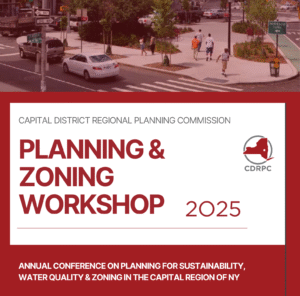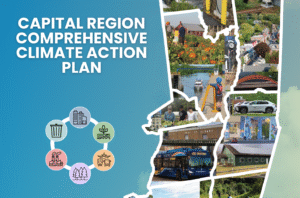An Analysis of COVID-19’s Impact on Capital Region Employment
In the United States and all over the world, unemployment stands as an important indicator of not only economic trends, but of significant world events. Employment has historically reacted to world events, both human and natural, growing when times are good and falling when times are bad. This remains especially true today, with the coronavirus pandemic sweeping over the world. COVID-19 has had a severe effect on employment in both New York State and the Capital Region.
COVID-19 caused an unprecedented and almost instantaneous increase in the unemployment rate, jumping from 4.4% in March 2020 to 15.6% by June 2020. This shift in the unemployment rate is unlike any other recession we have seen since the 1970s. In 1976, unemployment similarly spiked to 11.1% in New York State, but the increase took place over a year to reach that height. The Great Recession, taking place between 2009 and 2013, saw an unemployment rate that never got as high as 1976 but was drawn out over a much longer period of time.
COVID-19 Impact on Employment
Compared to past recessions, COVID-19’s impact has been far more severe. COVID-19’s impact in New York roughly began in the middle of March. In March 2020, the unemployment rate in New York was 4.4%. In the next month, the unemployment rate jumped to 15%, higher than any other month in the past 46 years. After dropping slightly to 14.2% in May 2020, the unemployment rate increased to 15.6% in June 2020, the highest single month total in all our recorded data.
The Capital Region saw a very similar trend to New York State, with a jump from 4% to 12.6% between March 2020 and April 2020. The rate declined back down to 9.6% in May 2020 but jumped back to 10.5% in June.
Overall. the Capital Region has shown to be more resilient in times of recession or economic hardship than the rest of state. While the unemployment rate in the region did increase when the pandemic started, it did not rise as high as the state’s unemployment rate. Being more resilient is a good sign for recovery in the region.
It is important to note that in past recessions, New York State did not need to shut down the way that we have during the COVID-19 pandemic. However, these data trends show how devastating a pandemic can be on unemployment, greater than any recession in recent memory, and how far we still must go to fight the pandemic to make it safe for people to return to work.
Weekly Unemployment Claims
Initially, the pandemic’s weekly impact on unemployment claims was severe, but has slowly been trending back down. Utilizing data from the New York State Department of Labor regarding weekly unemployment claims, we can see real time changes in employment throughout the 8-county Greater Capital Region. During the week ending in March 8th, right before COVID-19’s full impact was felt in New York, there were 600 unemployment claims, right along the pre-pandemic average. However, the next week saw 4,062 claims and 18,644 claims the week after that. This massive jump in claims shows how quickly the pandemics effects were felt in the region.
The week ending in March 22nd’s 18,644 was the highest single day total for the region but was followed by 14,468 and 15,029 claims over the next two weeks. Claims would see a decline between April 12th and May 17th, reaching as low as 7,359 and as high as 9,092. While these are still very high unemployment claims, they are a reduction from the massive numbers seen in the three weeks before this period.
After the week ending in May 17th, claims dropped again. The week ending in May 24th saw just 2,876 claims. The number of unemployment claims has remained around this level through the week ending in July 19th. While it is an improvement from previous weeks, it is still much higher than the yearly average. However, these trends do seem to show people are slowly getting back to work in the region.
CDRPC updates our visualizations with the most up to date employment data every month. You can check out our employment data on our website here.
Comparison Periods
While there have been various recessions since 1974 in New York State, we are highlighting two recessions that have had a significant effect on unemployment. The heights of these two recessions occurred in 1976 and 2010.
In 1976, the unemployment rate in New York State hit a high of 11.1% in consecutive months, January and February, after months of steady incline. The unemployment rate grew from a low of 5.3% in May 1974 and increased through February. In the Capital District, unemployment reached its height around the same time, hitting 9.13% in February 1976. The unemployment rate began its increase in August of 1974 at 3.6%.
The Great Recession, taking place between 2007 and 2009, had a prolonged effect on unemployment, keeping the rate high for four years. In New York State, significant unemployment increases began after April 2008, jumping from a 4.5% unemployment rate to 7.7% by January 2009. The unemployment rate would continue to increase with a sustained period of high unemployment between July 2009 and February 2013. During this time, the monthly unemployment rate remained above 8% consistently except for two months, April and May 2011, where the rate dipped to 7.7% and 7.8% respectively.
In the Capital Region, unemployment followed a similar path. After April 2008, in which the unemployment rate was at 4.3%, the rate continued to increase through January 2010 where the rate reached a height of 8.1%. This rate maintained a high level through January 2013.


